
Browse an alphabetical list of photographs. These historical images portray people, places, and events before, during, and after World War II and the Holocaust.
<< Previous | Displaying results 1751-1775 of 2641 for "Photo" | Next >>
Photograph from SS General Juergen Stroop's report showing the Warsaw ghetto after the German suppression of the ghetto uprising. Stroop, commander of German forces that suppressed the Warsaw ghetto uprising, compiled an album of photographs and other materials. This album later came to known as "The Stroop Report." The right of this image from the album shows a column of Jews being transported out of the ghetto for deportation. Warsaw, Poland, April–May, 1943.
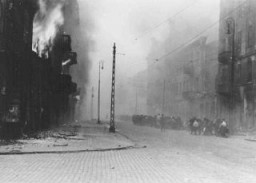
Anne Frank at five years of age. Bad Aachen, Germany, September 11, 1934.

Close-up street portrait of Dawid Samoszul, probably taken in Piotrkow Trybunalski, Poland, between 1936 and 1938. Dawid was killed in the Treblinka killing center at the age of 9.
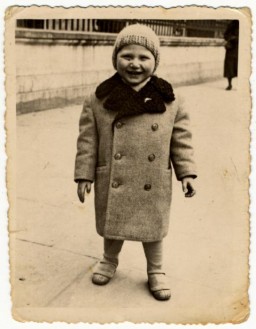
Kitty Weichherz, pictured here in a photograph taken before World War II began, was born in December 1929. This photo was taken from a diary of Kitty's life written by her father, Bela Weichherz. After Kitty's birth, Bela started to keep a diary of his daughter's life. He made entries recording her childhood in Czechoslovakia until the family was separated and deported during the Holocaust. His last entry reads "I only wish that we can go together." Kitty and all of her immediate family perished in the…
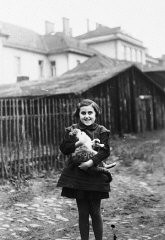
Robert Coopman was born in the Netherlands in September 1940. This 1941 photograph shows Robert holding a telephone while sitting next to a teddy bear. He and his parents lived in Amsterdam where his father was a salesman and bookkeeper. In July 1942, fearing for their safety, Robert's parents placed him in hiding with the Viejou family in Naarden. He was less than two years old. He lived as a member of the household until August 1944, when a neighbor betrayed them. Robert was …
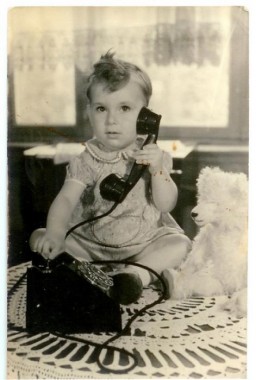
The Machefer family in Oradour. All of the people pictured here, except for the father, were killed by the SS during the June 10, 1944, massacre. Oradour-sur-Glane, France, October 1943.
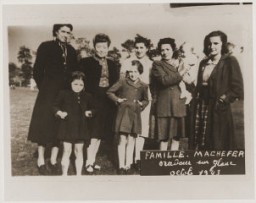
Photograph of the water tower of the Old Town Mills in Prague. After her deportation to the Theresienstadt ghetto in Czechoslovakia, Helene Reik yearned to record what was happening to her. This photograph was sent to Helene, who used it as paper for her diary in Theresienstadt. Helene’s makeshift diary offers wistful memories of her husband and parents who died before the war, loving thoughts of her family who had left Europe in 1939, and a firsthand account of the illness and hospitalization that…
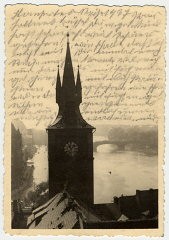
Photograph of Thomas with his wife, Peggy. With the end of World War II and collapse of the Nazi regime, survivors of the Holocaust faced the daunting task of rebuilding their lives. With little in the way of financial resources and few, if any, surviving family members, most eventually emigrated from Europe to start their lives again. Between 1945 and 1952, more than 80,000 Holocaust survivors immigrated to the United States. Thomas was one of them.
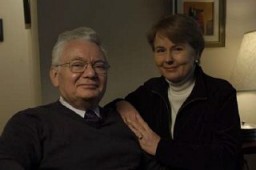
Photograph taken in 1984 of Thomas Buergenthal's mother, Gerda, then in her early 70s.
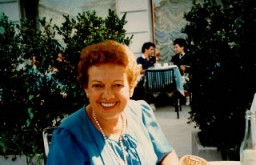
Photograph showing Helene Reik's family members and friends gathered in March 1941 in Brazil. After her deportation to the Theresienstadt ghetto in Czechoslovakia, Helene yearned to record what was happening to her. This photograph was sent to Helene, who used it as paper for her diary in Theresienstadt. Helene’s makeshift diary offers wistful memories of her husband and parents who died before the war, loving thoughts of her family who had left Europe in 1939, and a firsthand account of the illness…

Photograph showing Kurt, Helene Reik's son, and his wife, while on vacation in April/May 1938 in Kupari, Croatia. After her deportation to the Theresienstadt ghetto in Czechoslovakia, Helene yearned to record what was happening to her. This photograph was sent to Helene, who used it as paper for her diary in Theresienstadt. Helene’s makeshift diary offers wistful memories of her husband and parents who died before the war, loving thoughts of her family who had left Europe in 1939, and a firsthand…
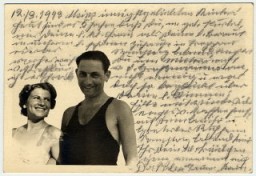
Photograph showing Kurt, Helene Reik's son, holding his baby Margarida, in Rio de Janeiro in 1940. After her deportation to the Theresienstadt ghetto in Czechoslovakia, Helene yearned to record what was happening to her. This photograph was sent to Helene, who used it as paper for her diary in Theresienstadt. Helene’s makeshift diary offers wistful memories of her husband and parents who died before the war, loving thoughts of her family who had left Europe in 1939, and a firsthand account of the…
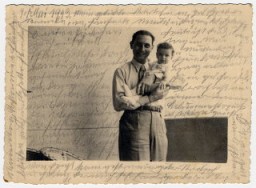
Photograph showing Margarida, Helene Reik's granddaughter, playing on a field in Teresopolis, Brazil, in April 1940. After her deportation to the Theresienstadt ghetto in Czechoslovakia, Helene yearned to record what was happening to her. This photograph was sent to Helene, who used it as paper for her diary in Theresienstadt. Helene’s makeshift diary offers wistful memories of her husband and parents who died before the war, loving thoughts of her family who had left Europe in 1939, and a firsthand…
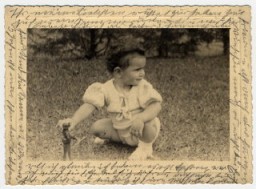
Photograph taken at the marriage of Esther Salsitz and her fiance. Esther's parents, Norman and Amalie, stand at left and right (respectively). June 19, 1977. With the end of World War II and collapse of the Nazi regime, survivors of the Holocaust faced the daunting task of rebuilding their lives. With little in the way of financial resources and few, if any, surviving family members, most eventually emigrated from Europe to start their lives again. Between 1945 and 1952, more than 80,000 Holocaust…

Photograph taken in May 1915 of Helene Reik's children. After her deportation to the Theresienstadt ghetto in Czechoslovakia, Helene yearned to record what was happening to her. This photograph was sent to Helene, who used it as paper for her diary in Theresienstadt. Helene’s makeshift diary offers wistful memories of her husband and parents who died before the war, loving thoughts of her family who had left Europe in 1939, and a firsthand account of the illness and hospitalization that ultimately…
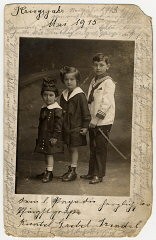
Members of the press during the trial of John Demjanjuk. Jerusalem, Israel, March 18, 1987.
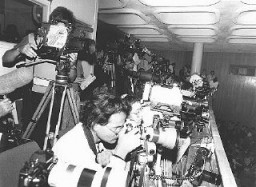
Pierre Laval, head of the government of Vichy France and Nazi collaborator. Shown here delivering a radio address. France, 1941–42.
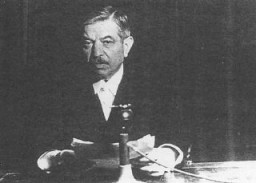
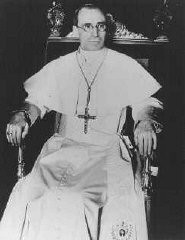
A newspaper clipping with the headline "Against the Un-German Spirit" announces the plundering of the Institute for Sexual Science. The photo shows students marching to the institute's entrance before the looting began on May 6, 1933. The institute's books and documents were among those targeted during the Nazi book burnings.
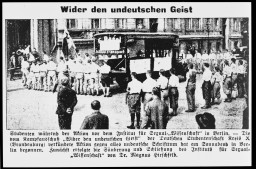
Poles walk among the ruins of besieged Warsaw. This photograph documenting war destruction was taken by Julien Bryan (1899-1974), a documentary filmmaker who filmed and photographed the everyday life and culture of individuals and communities in various countries around the globe.
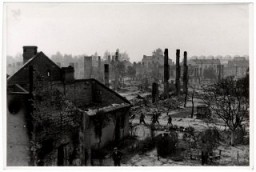
Headquarters of the Nazi Gestapo (secret state police) and of the Reich Security Main Office (RSHA). Berlin, Germany, date uncertain.
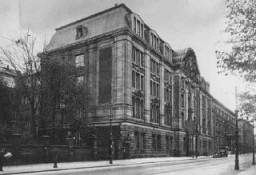
Policemen stand outside the shuttered Eldorado nightclub, long frequented by Berlin's gay and lesbian community. The Nazi government quickly closed the establishment down and pasted pro-Nazi election posters on the building. Berlin, Germany, March 5, 1933. Learn more about this photograph.
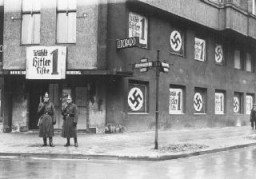
Police search a messenger at the entrance to the building where Vorwaerts, a Social-Democratic Party newspaper, was published. The building was subsequently occupied during the suppression of the political left wing in Germany that was carried out in response to the Reichstag Fire. Berlin, Germany, March 3–4, 1933.
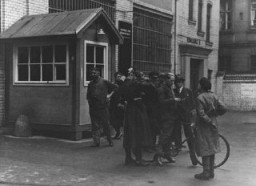
Police search in Berlin. Members of the SA stand nearby. Berlin, Germany, 1933.
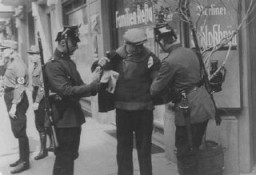
Polish and Russian forced laborers shot by the SS after they had collapsed from exhaustion during a death march. Wisenfeld, Germany, April 26, 1945.

We would like to thank Crown Family Philanthropies, Abe and Ida Cooper Foundation, the Claims Conference, EVZ, and BMF for supporting the ongoing work to create content and resources for the Holocaust Encyclopedia. View the list of donor acknowledgement.